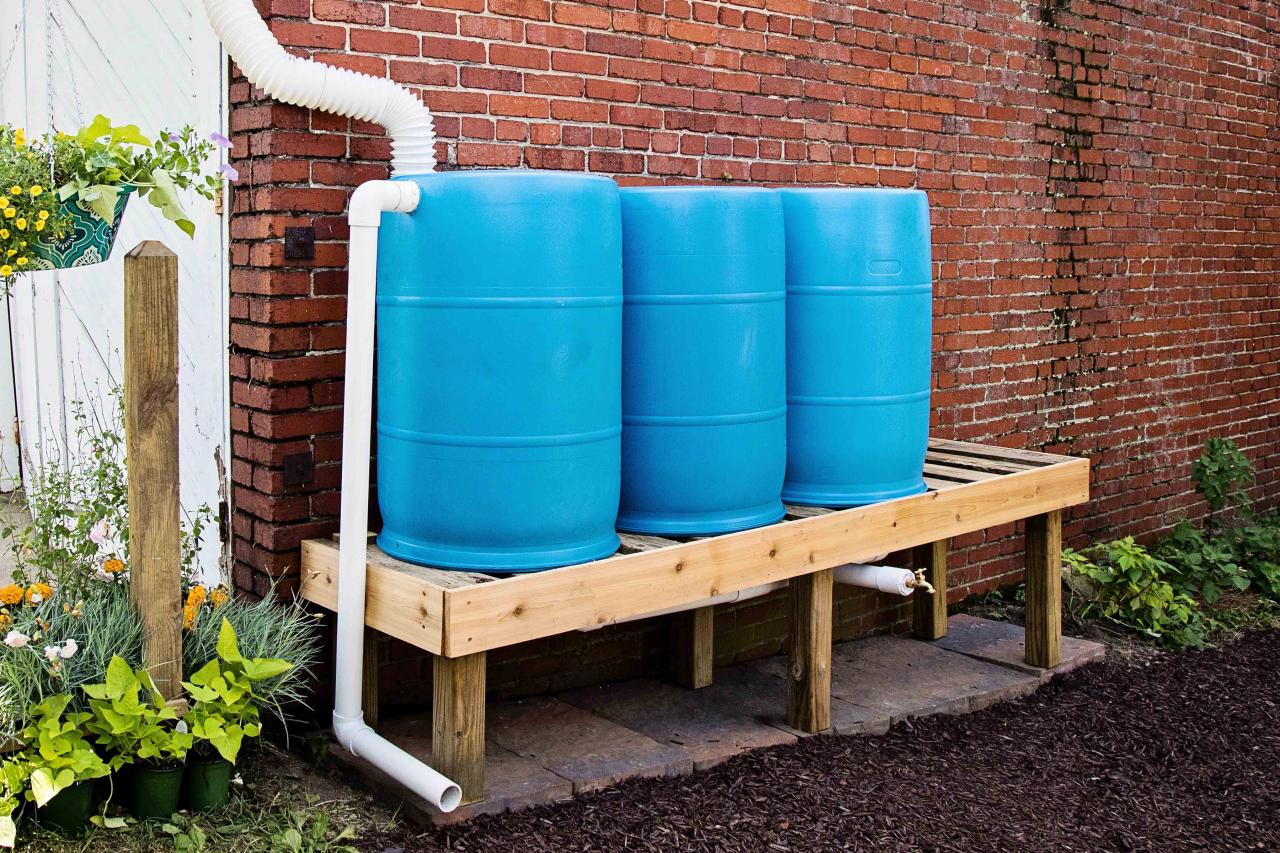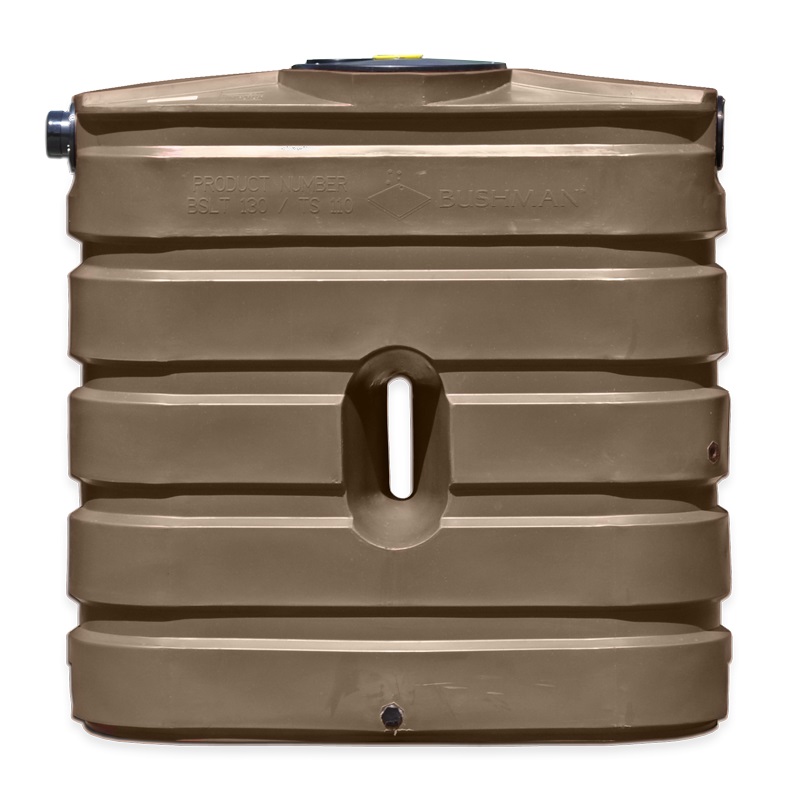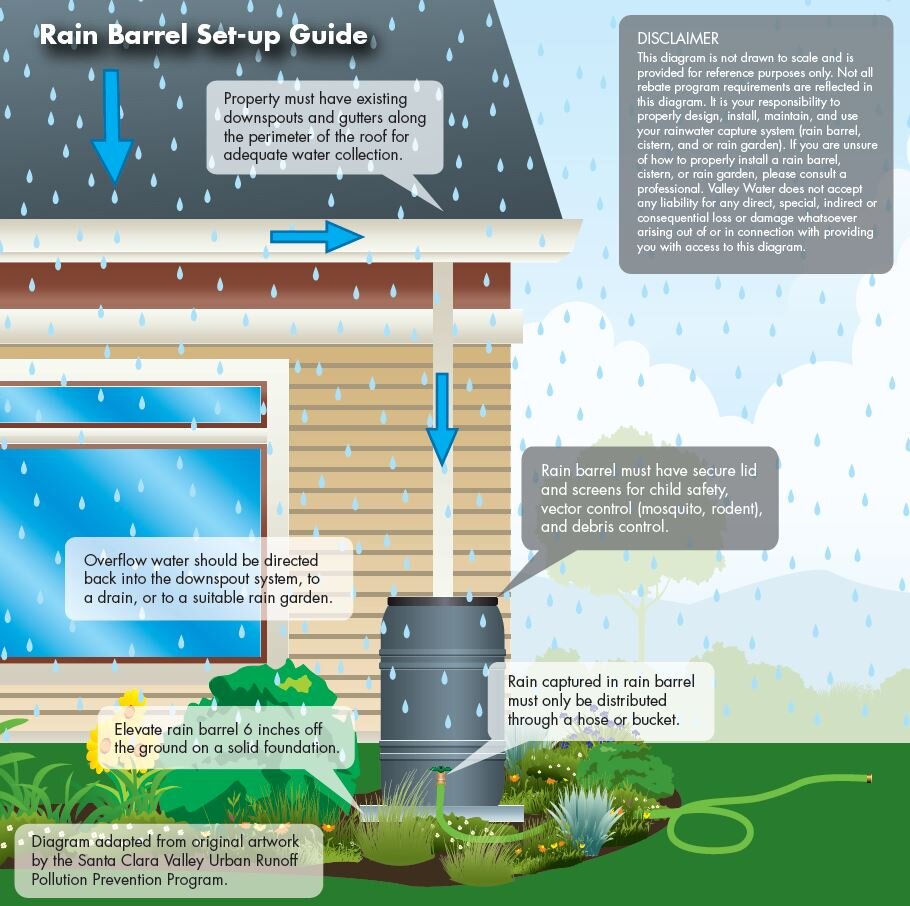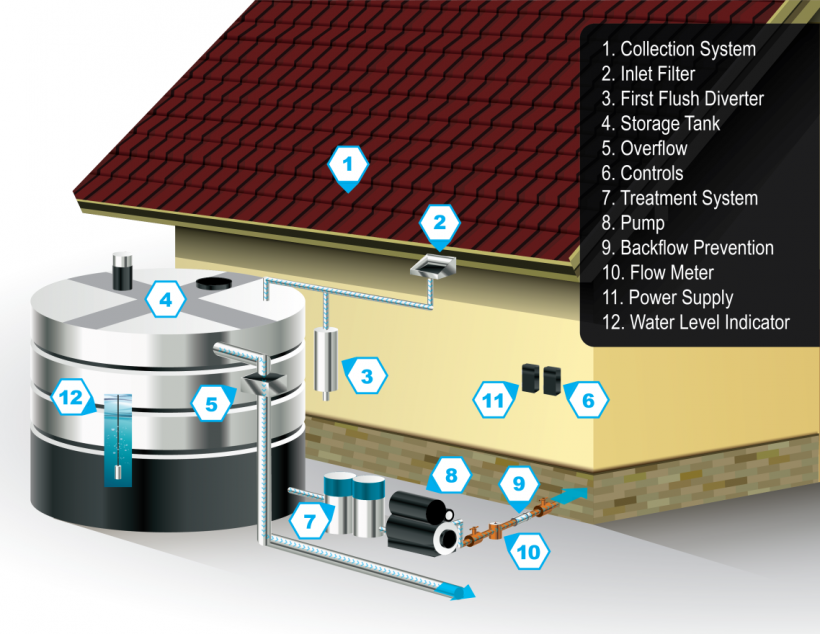Seriously Saving Water: From Barrels to Cisterns

Build your own rainwater harvesting system for outdoor use
Let’s start with a quiz: say you have a roof that measures 1700 square feet (average for the US) and your area has a rainstorm that yields half an inch, how much water can you potentially collect with a home rainwater harvesting system?
The answer is about 425 gallons: multiply 1700 sq. ft. by 0.5 inches and the conversion factor* of 0.62 and a collection factor* of about 81%. (Well-designed and implemented collection systems achieve a collection factor of 75% to 90%.) Storing all of this water would require eight 55-gallon barrels. Imagine all of this good water going to waste!
Rainfall Collected (gal) = Catchment Area (roof size)(square feet) × Rainfall (inches) × Conversion Factor (0.62) × Collection Factor (75% to 90%)
*Conversion factor is a constant used to convert square footage of a surface and inches of rainfall into a number of gallons.
*Collection factor is a measurement of the efficiency of the system expressed as a percentage; the angle of the roof slope and any leaks in the system are contributors.
In the last newsletter, we looked at Laundry to Landscape (L2L) systems and programs that Bay Area water providers offer for helping the homeowner to set up such systems for irrigation; this time, we’ll look at simple, gravity-fed rainwater harvesting systems, also intended for irrigation.
The fundamental concept of a rainwater harvesting system:
- Catch water that falls on a roof or other flat surface
- Channel water into one or more collection vessels
- Store water until needed

Here we see a difference between a L2L system and a rainwater collection system: L2L systems aren’t intended to store water (maximum of 24 hours); in contrast, rainwater harvesting systems are intended to store water indefinitely when following the recommendations of the manufacturer of the storage tank.
A rainwater harvesting system has a storage tank that’s waterproof, unlike most wells, and is usually referred to as a cistern or rain barrel, if not simply a water tank. Tanks under 55 gallons are usually called rain barrels; larger tanks (100 to thousands of gallons) are often called cisterns, whether they’re above or below ground.
Like an L2L system, we’ll consider the water in a rainwater harvesting system to be non-potable without further treatment.

Required components
- Collection system: a roof or other flat, gradually slanted surface
- Gutters and downspouts: for collecting rainwater runoff at the low point(s) of the collection system
- Piping: made from PVC or HDPE
- Inlet filter: filters the water as it passes through the gutter’s downspout. It’s also called a leaf excluder or a rain head. (Note: if the water will be used for drip irrigation, your system must exclude particles larger than 100 microns. Otherwise, a 1/16-inch mesh is sufficient.)
- Water storage tank: a rain barrel or cistern on a solid foundation
- Mesh screening: California Plumbing Code (2016) 1602.9.5.8 requires a rainwater storage tank to include 1/16-inch mesh screening over vents to keep out insects, rodents, etc.
- Overflow mechanism: the barrel or cistern should overflow to a rain garden, a drain, or a chain of further vessels
Size your storage tank appropriately for the application of your rainwater harvesting system and for your area’s average rainfall. (You can use this rainwater availability map.) Usually, the lower your average rainfall, the larger your rain barrel or cistern needs to be. The tank should include an access port for maintenance and repairs, a vent to prevent the creation of a vacuum, and an overflow mechanism that allows at least as much outflow as inflow for your system.

The tank also must be enclosed and the vents and other openings screened with mesh of 1/16-inch or finer to keep out insects, rodents, birds, and amphibians. It should be either completely opaque or a dark color to inhibit photosynthesis and hence algae growth.
Because you’re designing a gravity-fed system without pumps, the inflow must release into the top of the tank. Keep in mind that a layer of sludge will build up at the bottom of the tank in the long term, and that sludge can be churned through the water during a rainstorm. The extent of this churn depends on the design of your system. A good analogy is pouring beer from a tap: letting the beer fall directly to the bottom of the glass produces the most agitation and therefore the most foam; pouring down the side of the glass yields less foam. Likewise, directing the water down the side of the tank slows its fall and thus produces less churn of the sludge. Because this is a non-potable system, this is probably a good thing, since the sludge may help fertilize plants, but the design is ultimately up to you.
The tank should feature a spigot for a hose. The spigot can be aligned flush with the bottom of the tank to allow sludge to be distributed gradually; a raised spigot increases maintenance, since it allows more sludge buildup on the bottom of the vessel.
A variety of rain barrels and cisterns, including “slimline” tanks designed to fit through a doorway easily, are available online from a wide selection of vendors.

Optional components
- Pumps are only needed if you need the water driven through a hose or pipe by pressure, rather than relying on gravity. This article focuses on a gravity-fed system, but pumps are an option if you’re designing a more advanced system.
- First flush diverter: Some rainwater harvesting systems are equipped with a first flush diverter that acts as a further debris excluder after the inlet filter. The first flush diverter is essentially a reservoir that catches the first flow of rainwater during a storm, with the goal of excluding any debris too small to be screened by the inlet filter. This first flush may include leaf fragments, evergreen needles, and particles of gravel, for example. The diverter isn’t strictly necessary, especially in a non-potable system, since, as noted above, the inlet filter already functions as a debris excluder. Many experts appreciate first flush diverters, but nevertheless don’t include them in systems they design; in practice, they aren’t cleaned as often as recommended, are very difficult to size optimally, and often exclude healthy fertilizer. Read more about first flush diverters to decide if you want to include one in your system. (Watch Rainwater Harvesting: First Flush Diverters A Waste Of Money?)
- Water level indicator: Since the tank should be opaque or a dark color, a water level indicator can help you know how full your system is. A wide variety are available: e.g., simple indicators don’t require power at all; more full-featured ones can connect to WiFi.
Other components, such as a power supply, devices for water treatment, automatic system controls, flow meters, and backflow prevention are ones to be aware of for advanced systems, but are beyond the scope of this article.
Maintenance
Twice a year: Clean your gutters as usual. Clean debris from the mesh filters. Inspect the inside of your collection tank for cracks and algae, and clean any buildup of sludge.
After every significant rainfall: If your system has a first flush diverter, empty and clean it out.
Follow manufacturers’ recommendations for cleaning your tank as often as recommended. Often you can use a solution of vinegar and water for cleaning, or add a drop or two of chlorine bleach.
Rebates
- SFPUC: Rebate of $100 each for a maximum of two rain barrels, or $350 for one cistern with capacity between 205 and 5,000 gallons.
- BAWSCA: up to $200 per rain barrel or cistern.
- Valley Water: $35 per rain barrel (40-199 gallons) or $0.50 per gallon of cistern capacity (200 or more gallons). Rebates can be significantly higher in cost-sharing areas such as Palo Alto, Cupertino, and Milpitas.
- San Jose Water: Uses the same rebates as Valley Water.
- East Bay MUD: No current rebates specific to rainwater harvesting. Contact East Bay MUD at [email protected] or 1-866-403-2683 for information about any future rain barrel and cistern programs. Check the East Bay MUD rainwater harvesting page and the East Bay MUD rebate page.
- Cal Water: No current rebates specific to rainwater harvesting. Contact Cal Water or check Cal Water rebates.
Links
- Federal Emergency Management Program: Rainwater Harvesting Systems
- Greywater Action on rainwater harvesting
- Rain barrel set-up guide
- To First Flush, or not to First Flush
- 2016 California Plumbing Code: Chapter 16, Nonpotable Rainwater Catchment Systems
- How to harvest rainwater (YouTube)
- RAINWATER COLLECTION FOR BEGINNERS | 16 Things To Know About Harvesting Rain Water BEFORE You Start (YouTube)
- Rainwater Harvesting QA – Cost, is it Illegal, how I treat, etc,. (YouTube)
- Rainwater Harvesting: First Flush Diverters A Waste Of Money? (YouTube)